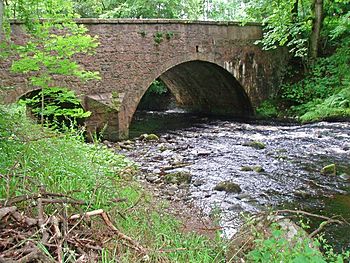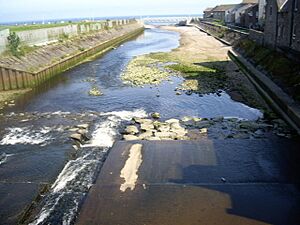Cowie Water facts for kids
Quick facts for kids Cowie Water |
|
|---|---|

Cowie Water, looking downstream at the A957 road bridge
|
|
| Native name | Scottish Gaelic: Uisge Chollaidh |
| Country | Scotland |
| Physical characteristics | |
| Main source | Grampian Mountains |
| River mouth | North Sea Stonehaven, Scotland 56°58′01″N 2°12′24″W / 56.96691°N 2.20667°W |
The Cowie Water (which is called Uisge Chollaidh in Scottish Gaelic) is a river in Scotland. It flows from the mountains and empties into the sea. This river is an important part of the landscape in the northeast of Scotland.
Contents
Where is Cowie Water?
The Cowie Water starts high up in the Grampian Mountains. These mountains are a large range in Scotland. The river then flows through an area called Kincardineshire.
The journey of the Cowie Water ends when it flows into the North Sea. This happens near the northern part of a town called Stonehaven. You can find the ruins of Cowie Castle just south of where the river meets the sea.
Rivers and Streams Joining Cowie Water
As the Cowie Water flows, it is joined by smaller rivers and streams. These are called tributaries. Two important tributaries are the Burn of Monboys and the Cowton Burn.
The Burn of Monboys flows through an area where an old Roman Camp called Raedykes was once located. This shows that the area around the Cowie Water has a long history.
Nearby Historic Places
The area around the Cowie Water is full of interesting historical sites. Not far from the river, you can find several famous castles. These include Dunnottar Castle, Fetteresso Castle, and Muchalls Castle.
These castles are popular places to visit. They offer a glimpse into Scotland's past. Other small waterways in the area also flow into the North Sea. These include the Burn of Muchalls to the north and the Carron Water to the south.
What is the Water Like?
Scientists sometimes study the water in rivers like the Cowie Water. They measure different things to understand how healthy the river is.
Water Flow and Quality
In the summer, the amount of water flowing out of the Cowie Water into the sea is usually around 200 cubic feet per second. This is like a lot of water moving quickly!
Scientists also check the water's pH level. This tells them if the water is acidic or alkaline. In July, the Cowie Water's pH was measured at 8.2. This means the water is slightly alkaline, which is often good for river life.
The water temperature in July is usually about 11.9 degrees Celsius. This is quite cool. Another measurement taken is electrical conductivity. This tells scientists how many dissolved salts are in the water. Near the mouth of the river, the conductivity was very low. This suggests the water is quite pure.
Scientists also look at turbidity. This means how cloudy or clear the water is. After a moderate rainfall, the water was a bit cloudy. This is normal, as rain can wash soil and other particles into the river.


